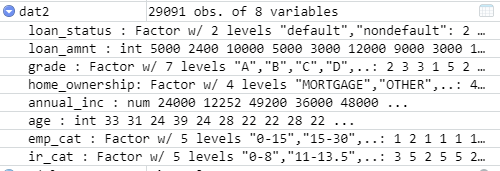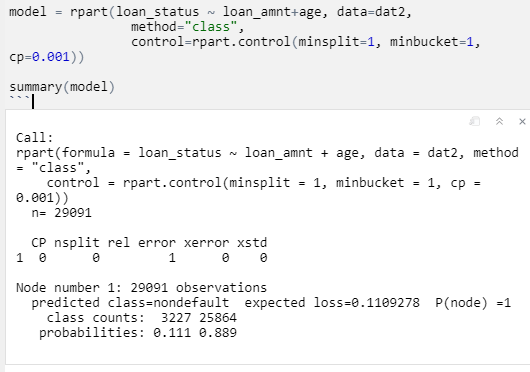You are not getting any splitting. I have never used fancyRpartPlot but it seems it does not like model with no splits. Here is an example using a built-in data set showing what the summary should look like.
library(rpart)
#> Warning: package 'rpart' was built under R version 3.5.3
fit <- rpart(Kyphosis ~ Age + Number + Start, data = kyphosis, method = "class")
summary(fit)
#> Call:
#> rpart(formula = Kyphosis ~ Age + Number + Start, data = kyphosis,
#> method = "class")
#> n= 81
#>
#> CP nsplit rel error xerror xstd
#> 1 0.17647059 0 1.0000000 1.000000 0.2155872
#> 2 0.01960784 1 0.8235294 1.058824 0.2200975
#> 3 0.01000000 4 0.7647059 1.058824 0.2200975
#>
#> Variable importance
#> Start Age Number
#> 64 24 12
#>
#> Node number 1: 81 observations, complexity param=0.1764706
#> predicted class=absent expected loss=0.2098765 P(node) =1
#> class counts: 64 17
#> probabilities: 0.790 0.210
#> left son=2 (62 obs) right son=3 (19 obs)
#> Primary splits:
#> Start < 8.5 to the right, improve=6.762330, (0 missing)
#> Number < 5.5 to the left, improve=2.866795, (0 missing)
#> Age < 39.5 to the left, improve=2.250212, (0 missing)
#> Surrogate splits:
#> Number < 6.5 to the left, agree=0.802, adj=0.158, (0 split)
#>
#> Node number 2: 62 observations, complexity param=0.01960784
#> predicted class=absent expected loss=0.09677419 P(node) =0.7654321
#> class counts: 56 6
#> probabilities: 0.903 0.097
#> left son=4 (29 obs) right son=5 (33 obs)
#> Primary splits:
#> Start < 14.5 to the right, improve=1.0205280, (0 missing)
#> Age < 55 to the left, improve=0.6848635, (0 missing)
#> Number < 4.5 to the left, improve=0.2975332, (0 missing)
#> Surrogate splits:
#> Number < 3.5 to the left, agree=0.645, adj=0.241, (0 split)
#> Age < 16 to the left, agree=0.597, adj=0.138, (0 split)
#>
#> Node number 3: 19 observations
#> predicted class=present expected loss=0.4210526 P(node) =0.2345679
#> class counts: 8 11
#> probabilities: 0.421 0.579
#>
#> Node number 4: 29 observations
#> predicted class=absent expected loss=0 P(node) =0.3580247
#> class counts: 29 0
#> probabilities: 1.000 0.000
#>
#> Node number 5: 33 observations, complexity param=0.01960784
#> predicted class=absent expected loss=0.1818182 P(node) =0.4074074
#> class counts: 27 6
#> probabilities: 0.818 0.182
#> left son=10 (12 obs) right son=11 (21 obs)
#> Primary splits:
#> Age < 55 to the left, improve=1.2467530, (0 missing)
#> Start < 12.5 to the right, improve=0.2887701, (0 missing)
#> Number < 3.5 to the right, improve=0.1753247, (0 missing)
#> Surrogate splits:
#> Start < 9.5 to the left, agree=0.758, adj=0.333, (0 split)
#> Number < 5.5 to the right, agree=0.697, adj=0.167, (0 split)
#>
#> Node number 10: 12 observations
#> predicted class=absent expected loss=0 P(node) =0.1481481
#> class counts: 12 0
#> probabilities: 1.000 0.000
#>
#> Node number 11: 21 observations, complexity param=0.01960784
#> predicted class=absent expected loss=0.2857143 P(node) =0.2592593
#> class counts: 15 6
#> probabilities: 0.714 0.286
#> left son=22 (14 obs) right son=23 (7 obs)
#> Primary splits:
#> Age < 111 to the right, improve=1.71428600, (0 missing)
#> Start < 12.5 to the right, improve=0.79365080, (0 missing)
#> Number < 3.5 to the right, improve=0.07142857, (0 missing)
#>
#> Node number 22: 14 observations
#> predicted class=absent expected loss=0.1428571 P(node) =0.1728395
#> class counts: 12 2
#> probabilities: 0.857 0.143
#>
#> Node number 23: 7 observations
#> predicted class=present expected loss=0.4285714 P(node) =0.08641975
#> class counts: 3 4
#> probabilities: 0.429 0.571
Created on 2019-11-04 by the reprex package (v0.3.0.9000)

